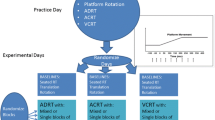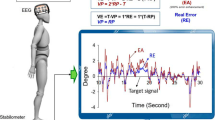Abstract
The study used a dual-task (DT) postural paradigm (two tasks performed at once) that included electroencephalography (EEG) to examine cortical interference when a visual working memory (VWM) task was paired with a postural task. The change detection task was used, as it requires storage of information without updating or manipulation and predicts VWM capacity. Ground reaction forces (GRFs) (horizontal and vertical), EMG, and EEG elements, time locked to support surface perturbations, were used to infer the active neural processes underlying the automatic control of balance in 14 young adults. A significant reduction was seen between single task (ST) and DT conditions in VWM capacity (F(1,13) = 6.175, p < 0.05, r = 06) and event-related potential (ERP) N1 component amplitude over the L motor (p < 0.001) and R sensory (p < 0.05) cortical areas. In addition, a significant increase in the COP trajectory peak (pkcopx) was seen in the DT versus ST condition. Modulation of VWM capacity as well as ERP amplitude and pkcopx in DT conditions provided evidence of an interference pattern, suggesting that the two modalities shared a similar set of attentional resources. The results provide direct evidence of the competition for central processing attentional resources between the two modalities, through the reduction in amplitude of the ERP evoked by the postural perturbation.


Similar content being viewed by others
References
Adkin AL, Quant S, Maki BE, McIlroy WE (2006) Cortical responses associated with predictable and unpredictable compensatory balance reactions. Exp Brain Res 172:85–93
Adkin AL, Campbell AD, Chua R, Carpenter MG (2008) The influence of postural threat on the cortical response to unpredictable and predictable postural perturbations. Neuro Lett 435:120–125
Beloozerova IN, Sirota MG, Swadlow HA, Orlovsky GN, Popova LB, Deliagina TG (2003) Activity of different classes of neurons of the motor cortex during postural corrections. J Neurosci 23(21):7844–7853
Brooks VB (1984) Cerebellar functions in motor control. Hum Neurobiol 2:251–260
Cocchini G, Logie RH, Della Sala S, MacPherson SE, Baddeley AD (2002) Concurrent performance of two memory tasks: evidence for domain-specific working memory systems. Mem Cogn 30(7):1086–1095
Dault MC, Frank J, Allard F (2001) Influence of a visuo-spatial, verbal and central executive working memory task on postural control. Gait Posture 14:110–116
Dietz V, Quintern J, Berger W (1984) Cerebral evoked potentials associated with the compensatory reactions following stance and gait perturbation. Neurosci Lett 50:181–186
Dietz V, Quintern J, Berger W, Schenck E (1985) Cerebral potentials and leg muscle e.m.g. responses associated with stance perturbation. Exp Brain Res 57:354–384
Field A (2009) Discovering statistics using SPS, 3rd edn. SAGE Publications, London
Hillyard SA, Vogel EK, Luck SJ (1998) Sensory gain control (amplification) as a mechanism of selective attention: electrophysiological and neuroimaging evidence. Philos Trans R Soc Biol Sci 353:1257–1270
Hollman JH, Youdas JW, Lanzino DJ (2011) Gender differences in dual task gait performance in older adults. Am J Mens Health 5(1):11–17
Hopf JM, Vogel EK, Woodman GF, Heinze HJ, Luck SJ (2002) Localizing visual discrimination processes in time and space. J Neurophysiol 88:2088–2095
Horak FB, Nashner LM (1986) Central programming of postural movements: adaptation to altered support-surface configurations. J Neurophysiol 55(6):1369–1381
Horak FB, Nashner LM, Nutt JG (1988) Postural instability in Parkinson disease: motor coordination and sensory organization. Neurol Rep 12:54–55
Horak FB, Diener HC, Nashner LM (1989) Influence of central set on human postural responses. J Neurophysiol 62(4):841–853
Huxhold O, Li SC, Schmiedek F, Lindenberger U (2006) Dual-tasking postural control; aging and the effects of cognitive demand in conjunction with focus of attention. Brain Res Bull 69:294–305
Jacobs JV, Horak FB (2007) External postural perturbations induce multiple anticipatory postural adjustments when subjects cannot pre-select their stepping foot. Exp Brain Res 179:29–42
Lajoie Y, Teasdale N, Bard C, Fleury M (1993) Attentional demands for static and dynamic equilibrium. Exp Brain Res 97:139–144
Little CE, Woollacott M (2014) Effect of attentional interference on balance recovery in older adults. Exp Brain Res. doi:10.1007/S00221-014-3894-0
Logie RH, Zucco GM, Baddeley AD (1990) Interference with visual short-term memory. Acta Psychol 75:55–74
Luck SJ (2005) An Introduction to the Event-Related Potential Technique. 1st Edition, MIT Press
Macpherson JM, Inglis JT (1993) Stance and balance following bilateral labyrinthectomy. Prog Brain Res 97:219–228
Macpherson JM, Horak FB, Dunbar DC, Dow RS (1989) Stance dependence of automatic postural adjustments in humans. Exp Brain Res 78:557–566
Maki BE, Zecevic A, Bateni H, Kirshenbaum N, McIlroy WE (2001) Cognitive demands of executing postural reactions: does aging impede attention switching? NeuroReport 12:3583–3587
McCollough AW, Machizawa MG, Vogel EK (2007) Electrophysiological measures of maintaining representations in visual working memory. Cortex 43(1):77–94
McGowan JF, Duka T (2000) Hemispheric lateralization in a manual-verbal task combination: the role of modality and gender. Neuropsychologia 37(7):1018–1027
McIlroy WE, Norrie RG, Brooke JD, Bishop DC, Nelson AJ, Maki BE (1999) Temporal properties of attention sharing consequent to disturbed balance. NeuroReport 10:2895–2899
Mochizuki G, Sibley KM, Cheung HJ, Camilleri JM, McIlroy WE (2009) Generalizability of perturbation-Evoked cortical potentials: independence from sensory, motor and overall postural state. Neurosci Lett 451:40–44
Nashner M (1977) Fixed patterns of rapid postural responses among leg muscles during stance. Exp Brain Res 30:13–24
Nashner LM, Cordo PJ (1981) Relation of automatic postural responses and reaction-time voluntary movements of human leg muscles. Exp Brain Res 43(3–4):395–405
Norrie RG, Maki BE, Staines WR, McIlroy WE (2002) The time course of attention shifts following perturbation of upright stance. Exp Brain Res 146:315–321
Pashler H (1988) Familiarity and visual change detection. Percept Psycho-physiol 44:369–378
Quant S, Adkin AL, Staines WR, Maki BE, McIlroy WE (2004) The effect of a concurrent cognitive task on cortical potentials evoked by unpredictable balance perturbations. BMC Neurosci 5(18):1–12
Quant S, Maki BE, McIlroy WE (2005) The association between later cortical potentials and later phases of postural reactions evoked by perturbations to upright stance. Neurosci Lett 381:269–274
Runge CF, Shupert CL, Horak FB, Zajac FE (1999) Ankle and hip postural strategies defined by joint torques. Gait Posture 10:161–170
Saucier D, Bowman M, Elias L (2003) Sex differences in the effect of articulatory or spatial dual-task interference during navigation. Brain Cogn 53(2):346–350
Siu K-C, Chou L-S, Mayr U, van Donkelaar P, Woollacott MH (2008) Does inability to allocate attention contribute to balance constraints during gait in older adults? J Gerontol Med Sci 634A(12):1364–1369
Vogel EK, Luck SJ (2000) The visual N1 component as an index of a discrimination process. Psychophysiology 37:190–223
Vogel EK, Machizawa MG (2004) Neural activity predicts individual differences in visual working memory capacity. Nature 428:748–751
Wellmon R (2012) Does the attentional demands of walking differ for older men and women living independently in the community? J Geriatr Phys Ther 35:55–61
Wickens CD (1983) Processing resources in attention, dual task performance, and workload assessment. In: Parasuraman R, Davies R (eds) Varieties of attention. Academic Press, New York, pp 63–102
Woollacott M, Vander Velde TJ (2008) Non-visual spatial tasks reveal increased interactions with stance postural control. Brain Res 1208:95–102
Xu Y, Chun MM (2006) Dissociable neural mechanisms supporting visual short-term memory for objects. Nature 440:91–95
Acknowledgments
This research was supported by the National Institute of Health, Grant #AG021598 to Dr Marjorie Woollacott (PI). The authors declare that they have no conflict of interest.
Author information
Authors and Affiliations
Corresponding author
Rights and permissions
About this article
Cite this article
Little, C.E., Woollacott, M. EEG measures reveal dual-task interference in postural performance in young adults. Exp Brain Res 233, 27–37 (2015). https://doi.org/10.1007/s00221-014-4111-x
Received:
Accepted:
Published:
Issue Date:
DOI: https://doi.org/10.1007/s00221-014-4111-x




